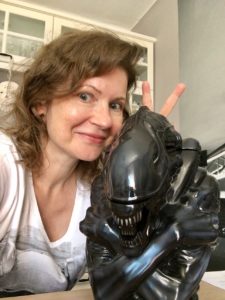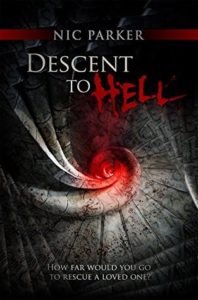I’m pleased to welcome back Nic Parker to the blog to talk about her revision process.
You can find her First Draft Process HERE.
 Nic was born in 1971. Her love for the horror genre flourished in early childhood. She enjoyed the opulence of genre productions in the eighties, chasing after forbidden video nasties with friends, and reading mainly Clive Barker and Stephen King.
Nic was born in 1971. Her love for the horror genre flourished in early childhood. She enjoyed the opulence of genre productions in the eighties, chasing after forbidden video nasties with friends, and reading mainly Clive Barker and Stephen King.
Since her twenties she’s had the pleasure of meeting and interviewing many household names from the horror genre in her role as a journalist for Moviestar magazine.
She is an avid book collector, passionate about art and likes to try out new recipes from her many cookbooks.
Parker lives in rural Germany with her husband and six cats.
‘Descent to Hell’ is the first part in the Hell trilogy with main character Charlie Ward.
Your first draft has been completed, what state is it generally in?
The story I wanted to tell is about 90 percent complete.
What is the first thing do before you start to revise?
Let the whole thing rest! I’ve been working on it for so long I’d be unable to see the forest for the trees. So I don’t have any reservations to abandon it for at least a fortnight. If I should have a new idea during that time I note it down to be added when I am ready to go at it again.
How do you assess the damage that needs working on?
That depends. Normally the moment I start writing the story is almost complete in my head, which means the damage – missing plot, missing characters, etc. – is probably limited.
Do you allow anyone to read that very first draft before revisions or can you assess it objectively yourself?
That depends, if it’s just to hear if the story in general is appealing/working I might pass it on to one or two good friends but usually I’d want to go through at least one more draft before I give it out to read.
What do you initially focus on, when approaching the completed first draft of the manuscript?
I will do several smaller editing processes concerning characters, if the plot has holes the size of a crater, continuity and fucking repetitions of things I’ve already mentioned a few paragraphs back in the story.
Do you have any rituals, writing or real-world, when revising a manuscript?
Free flow of coffee, and leaving every other shit just be while I am at it…well, maybe not feeding the cats but household chores, preparing a warm meal or social media are put on hold. I am trying to plough through the whole revision thing in three to five days maximum, which is essential so I can immerse myself in the story and don’t have to go back frequently to think about what I have written in that chapter.
In what format do you revise, paper or computer?
Computer, can’t stand to leaf through so many paper pages…
How messy is the revision process – can you go in and repair areas or does the whole manuscript get decimated?
The manuscript mostly stays in its original form with chapters being expanded or extremely cut. I remember taking out almost 20.000 words from my first manuscript, I wanted it to be sharp and fast and the reader doesn’t need over-explaining, they get it quite fast.
Is revision an overhaul of the story or is it minor editing?
Usually the latter as the construction of the story is solid enough. That doesn’t mean I’d call the editing minor, as sometimes it’s worse to get all the little details right than applying a big change in the plot.
What’s the biggest change you’ve made to a story during this process?
Probably deleting about 10.000 words already…
When first drafting, many writers keep track of progress by counting words in a day. How do you make sure you’re progressing as you’re revising?
Like I said, the first revision happens in a matter of days, so in the matter of a week the first revision has to be finished.
Do you prefer to write the first draft or do you prefer the revision process?
I guess nothing beats bringing a story to the page for the first draft!
 What do you drink while you’re working?
What do you drink while you’re working?
Coffee, still water and Coke – boring, I know!
How long does this process take and what shape is the book now in?
Luckily, the revision takes less time than writing the damned thing and I’d say it’s about in a good structural shape and the flow is smooth.
Thanks for showing us the inner workings!
My pleasure – thanks so much for letting me blab!
You can find Nic on her website and Amazon
Descent to Hell
 A man forced to enter mankind’s most feared territory … a child dragged into the underworld!
A man forced to enter mankind’s most feared territory … a child dragged into the underworld!
When Charlie Ward’s beloved niece is kidnapped by an atrocious demon he has to find the secret gateway into the one place every human wants to stay away from: Hell!
Armed only with courage and determination Charlie has to survive in a forbidding place filled with despair and anguish. He must face challenges no mortal should ever have to undergo that threaten to destroy his very soul.



Sounds like a solid process – what I wouldn’t give for a decent first draft! I’m about to delve into my revisions after 2 months away from it… I might need Nic’s skull mug 🙂
Ha, everyone likes the skull mug ???? – they are available on Amazon.co.uk, just look for ‘creepy cups’ xx
My first drafts aren’t that messy either. No major revisions, just a million little ones.
Really like your xenomorph!
My Xenomorph and I are best buddies and it’s got a secret – it’s a cookie jar ???? So a very practical Xenomorph ???? xx
It’s always so interesting to learn how other authors go about it – thanks, both. And I know just what you mean about letting a manuscript ‘rest’ for a bit before editing. I do the same thing. Oh, and I couldn’t agree more about the free flow of coffee. To me, it’s a major food group…
Margot, coffee is definitely a staple food! No life possible without covfefe ???? xx